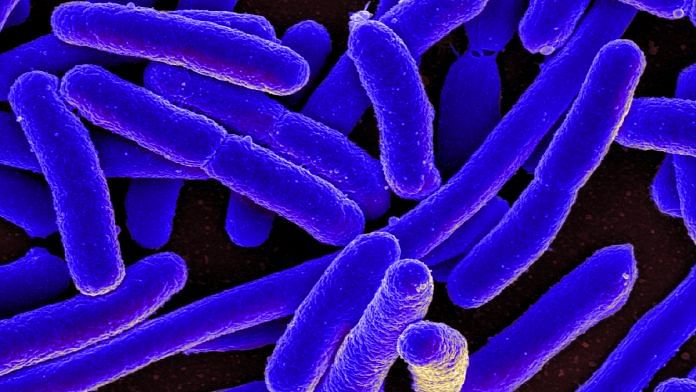Gene editing to store messages in bacterial DNA
Scientists at Columbia University have used a gene editing tool called CRISPR to encode and store data inside living bacterial cells.
There has been growing interest in using DNA as a storage medium for data. Genetic material effectively encodes data that allows life forms to function using the four DNA bases — adenine (A), cytosine (C), thymine (T) and guanine (G).
The scientists used genetic sequencing to tweak these codes to encode information. The DNA sequence can then be chemically synthesised in a laboratory, and even stored within everyday objects.
The team was also able to arrange DNA sequences to encode a text message that said “hello world!” inside E. coli cells. They were able to decode the message by extracting and sequencing the bacterial DNA.
The reason researchers are trying to store information in living cells is because they could be a more stable medium for long-term storage in harsh conditions. While DNA kept outside cells can get degraded, bacteria have the ability to adapt to changing surroundings and can survive under harsh conditions.
There is still a long way to go before we start seeing real life organic storage systems that can replace our digital devices, because living cells have a major drawback — the DNA codes can change and introduce minor errors when cells replicate.
Read more about it here.
Also read: 2020 tied with 2016 for the hottest year ever recorded & why crocodiles don’t change
NASA fails to dig into Mars’ surface, ends mission
NASA has decided to end its mission to get a heat probe on Mars dig its way into the red planet’s surface, after several failed attempts. The heat probe called ‘mole’ was developed and built by the German Aerospace Center (DLR) and deployed on Mars by NASA’s InSight lander.
The heat probe was deployed in February 2019, and has been attempting to burrow into the Martian surface to take the planet’s internal temperature.
According to NASA, the soil’s unexpected tendency to clump had deprived the spike-like mole of the necessary friction it needed to hammer itself to a sufficient depth.
After getting the top of the mole about two to three centimeters under the Martian surface, the team had tried one last time to scrape soil onto the probe and ram it down. But despite some 500 hammer strokes, there was no progress.
The mole is a 16-inch-long pile driver connected to the lander with embedded temperature sensors. These sensors are designed to measure heat flowing from the planet once the mole has dug at least three meters deep.
While NASA’s Phoenix lander scraped the top layer of the Martian surface, no mission prior to InSight has tried to burrow into the planet’s soil. Read more here.
‘Neptune balls’ in oceans are cleaning up plastic waste
Human beings continue to dump plastic wastes into the oceans, but it appears as though underwater seagrass in coastal areas have found a coping mechanism to clean up trash.
A study has found that seagrass traps plastic pollution in natural bundles of fibre known as ‘Neptune balls’. The swaying plants can collect up to 900 million plastic items every year in the Mediterranean alone.
Seagrass plays a vital role in improving water quality, absorbing CO2, and is a natural nursery and refuge for hundreds of fish species.
The team found plastic particles in seaballs that had washed up on four beaches in Spain. Up to 600 plastic pieces were found in half of the loose seagrass leaf samples, while 17 per cent of the tighter bundled seagrass fibre known as ‘Neptune balls’ contained nearly 1,500 pieces per kilogram of seaball.
The balls are formed from leaves that have been shredded by ocean currents, but remain attached to stems. The damaged leaf sheaths form stiff fibres that intertwine into a ball, collecting plastic in the process. Read more in The Guardian.
‘Missing link’ that pushed Earth into Ice Age identified
An international consortium of scientists from universities around the world claim to have found the ‘missing link’ that had pushed Earth into the Ice Age.
According to them, melting icebergs in the Antarctic was the key that triggered a series of chain reactions, plunging Earth into a prolonged period of cold temperatures.
Ice Age cycles are paced by periodic changes to Earth’s orbit of the sun over thousands of years, which changes the amount of solar radiation that reaches our planet.
But how small variations in solar energy can trigger such dramatic shifts in the climate on Earth has remained a mystery until now. In their study, the team proposed that when the orbit of Earth around the sun is just right, icebergs begin to melt further and further away from Antarctica, shifting huge volumes of freshwater away from the Southern Ocean and into the Atlantic Ocean.
As the Southern Ocean gets saltier and the North Atlantic gets fresher, large scale ocean circulation patterns begin to dramatically change, pulling CO2 out of the atmosphere and reducing the greenhouse effect that keeps our planet warm.
This in turn pushes the Earth into ice age conditions. More on Independent.
Also read: Scientists discover 12 new deep-sea species in the Atlantic Ocean






